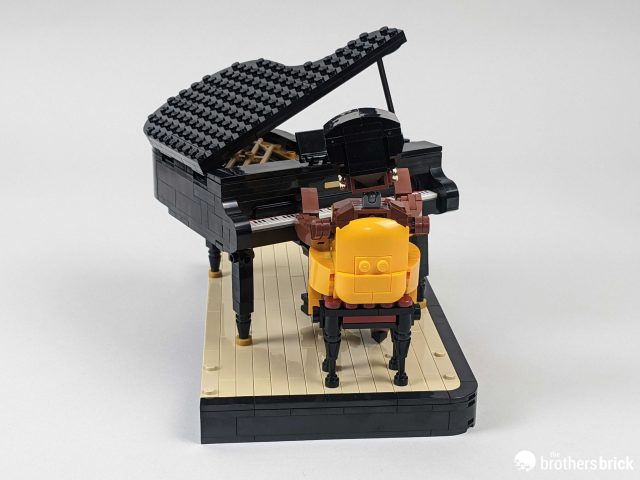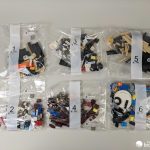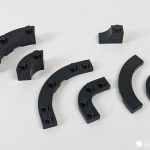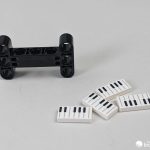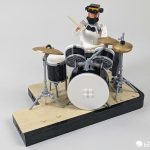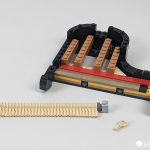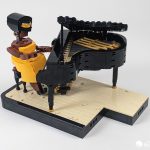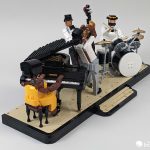Back in April of 2020 we featured a creation by builder Hsinwei Chi (LEGO7): A group of very hip musicians. Great stuff…and apparently LEGO (and the wider fan community) agreed. Thanks to a successful campaign via the Ideas program, this ensemble is about to hit the shelves as LEGO Ideas 21334: Jazz Quartet. Featuring a combo made of a pianist, bassist, trumpeter and drummer, this 1606 piece set will be available for VIP members starting June 28th (and July 1st for everyone) for US $99.99 | CAN $129.99 | UK £89.99. Take an early seat in the front row and see if this riff appeals to you!

The LEGO Group provided The Brothers Brick with an early copy of this set for review. Providing TBB with products for review guarantees neither coverage nor positive reviews.
Unboxing the parts, instructions and sticker sheet
This set comes in a medium sized, tab-sealed box. The styling here is standard for the Ideas theme – a minimalistic background with the set’s contents shown to good advantage in the center of the packaging. A “Jazz Quartet” logo dominates the upper left corner, and a dark red strip adds a touch of color to the lower edge. The age range is set at a mandatory 18+, but as usual that’s not a match for the actual complexity of the set. A much younger builder could easily handle the building challenges here. Also of note is the small logo in the lower right – this set can be a group build for 1-4 people, another reason to disregard the age suggestion and get the whole family involved.

The back of the box shows how the stage area can be broken up into individual stands for each of the four musicians. There’s also a glamor shot of the set in a home setting, as well as an inset that gives the set’s dimensions: 7.5″/20 cm tall by 17″/43cm wide.

Inside the box are 11 numbered parts bags, two loose black plates, and a tab-sealed cardboard envelope. The envelope has some colorful printing on it showing that it contains instructions, and the back also has a smaller sticker with set-specific info, presumably for inventory control purposes.
The envelope contains the five instruction manuals for this set. One for each musician, and an “overview” booklet that has information about the set and shows how to combine the individual figures into a single display. These staple-bound booklets are a departure from the usual singular Ideas perfect-bound tome, but a necessary change to allow for the multiple builder concept to work.

Another departure from the Ideas standards is the lack of any photography of the set’s Ideas designer or LEGO model builders. Instead, we’re treated to some hip character drawings that fit the jazz motif. We do get the usual interviews with the fan designer, Hsinwei Chi, as well as the master builders at LEGO who converted the initial design into the released set. In this case that’s Justin Ramsden, LEGO senior model designer, and Ollie Gregory, LEGO model designer.

The parts
As we’ve come to expect from the Ideas theme, this set includes a selection of interesting parts. First up are modified 1×1 2-plate high black bricks in black, and an unprinted version of the game controller minifigure accessory. Two printed slopes with the band’s “7” logo on them are a nod to the fan designer’s handle of “LEGO 7”. Other nifty elements include clear lightsaber bars, and a versatile modified connection element in light grey.
This 2×4 Windscreen in white has only appeared twice before, in 43179 Mickey & Minnie Mouse Buildable Characters and the 31117 Space Shuttle. There are also a number of curved plates in black that custom builders will find handy for their own creations.
There are two dishes in brushed gold ink, and a golden Technic wheel/hub combo. A selection of nougat elements joins a newer Technic bracket and printed 1×2 keyboard tiles.
Finishing up, there are a number of parts in the rare flame orange shade.

The Trumpeter
The first musician to be assembled is the trumpet player. The build starts out with his individual base and a set of stairs that will help unify the combined display. The trumpeter’s leg locks into the base, which is heavy enough to balance the completed figure.
The hips and torso are jointed with clip connections, and sloped tiles make sure things are aligned in a dynamic pose. A 1×4 tile in red forms the figure’s tie, bracketed by suspenders in dark red. The musician’s skin tone can start to be seen just behind the quarter circle tiles that form the shirt’s collar.

The trumpeter’s face is sculpted from a mix of 1×2 plate and tile, with a cheese wedge for a nose and 1×1 tooth plates shaping the ears. A 1×2 jumper plate invokes the pursed lips necessary to play the instrument.

Speaking of, the trumpet is made from a selection of gold-toned parts, mounted to a clip on the figure’s hand.

The completed figure leans back in a very energetic pose. There’s a small amount of articulation possible thanks to the ball-joint hinges in the shoulder and neck. This allows for a bit of customization of the pose, although you’ll probably just want to match what you see on the box.

Seen on their own, the trumpeter looks a little weak when seen straight on from the front or rear, but at any other angle they look great.
The Bassist
The construction on the bassist starts off very similar to the last build: A sturdy base with a layer of tan tile flooring. This time both feet are locked into the base, and there’s an additional ball joint connection for the double bass.

The figure’s legs and torso have nice organic shaping to them, thanks in part to automotive hood elements forming a bit of a belly. The unprinted game controller element looks great as a bow tie analog, too.

The bassist has a slightly lighter complexion than the trumpeter, a nice touch of diversity over just spamming the brick color for everyone. This musician’s upswept hair is also a very distinctive look, making these players unique beyond just their choice of instrument.

The double bass uses a combination of mirrored and SNOT building to create the graceful curves of the instrument. The strings are created by looping a LEGO stud-ended string around several connection points. I found this the most fiddly part of the build – there’s a fair bit of tension on that string, and it can pull the hinged plate at the base away from the build quite easily, or otherwise pull the neck pieces out of alignment.
The completed figure is another stand-alone success. The bass is well proportioned in comparison to the player, and the light articulation in the shoulders, elbows, and neck allow for some realistic posing.

The figure looks good in the round, with most angles providing a pleasing impression.

Joining the trumpeter, you have a nice little duo. The bases don’t connect at this stage, though.

The Drummer
The trumpeter and bassist were both built on smaller bases. Not so with the drummer, who requires a bit more real estate to set up. The base is again the first bit of construction to tackle. The notched shape on the right will allow for the other band member’s stands to join up eventually.

The bass drum has a reasonably complex interior structure to create its round shape. Bar and clip connections are used to fill in the gaps around 2×2 sloped tiles. This assembly is both sturdy and easy to build, so well-deserved kudos to the designers.
The tom toms are the next addition, with the one on the left having an additional layer of plate to differentiate it’s shape. A layer of round tile and plate create the drumheads.

The snare drum and stand tom are separate builds, connected to the base with transparent-clear rods. The kick pedal and bases for the cymbals are also added at this point.

The final bits of the kit are the ride, crash, and high-hat cymbals, as well as the drummer’s stool. I’m not a drummer myself, but to my untrained eye this looks like a very realistic kit.

The drummer features yet another skin tone, as well as some great rounded shapes in his torso. Once again the design from character to character varies, as this time the bow tie is made from two half-circle tiles. I also want to call out his great beard and snappy hat.

Tan bars serves as the drumsticks, and the articulation in the shoulders and elbows let you decide just how much energy this fellow is putting into the rhythm section.

The drummer locks securely onto is stool, making for a stable display. Again, rotation isn’t an issue as he looks good from most angles.

And just like that, our duo becomes a trio.

The Pianist
The final member of the quartet is the piano player. This section of the build starts out with another large block of stage that mirrors the shape of the drum’s half of the stage.

The piano has some interesting details and construction techniques, including this row of 31 modified 1×1 round plates with bars that create the key’s hammers. The shape of the piano is nicely curved, creating a shape that looks just like the real thing.

The rest of the piano’s housing comes together quickly, with plenty of real-world detailing.
The piano attaches securely to the stage on the exposed studs, as does the padded seat.

The pianist’s construction is similar in technique to the other band members, yet still retains her individuality. Her flame orange dress’s color is echoed in her headband, and two golden rings make for great hoop earrings.

The only complaint here is that the way the seat and piano are positioned it’s not possible to have both of her hands on the keys. Oh well…”action pose” it is!

Once again, this character can work as a stand-alone model. The complex shapes in the piano and dress help things to look great no matter what angle she’s displayed at.

The combined model
Slotting the pianist’s base into the group, you have the completed Jazz Quartet. There’s plenty of space between the figures, but they’re close enough to feel like a single band. The steps leading up to the stage are a nice touch that help unify the group visually.

You’ll probably want to make sure the band is seen from the front, but the other angles look pretty good, too. Do note that there’s a decent amount of overhang due to the piano – you’ll need a little deeper shelf space than you might first think.
There is a small problem in that the different sections of the stage don’t completely lock together. This may make alternate displays easier to assemble, but it does mean you have to make sure you don’t jostle your display or there’ll be obvious cracks in the floor. Take a close look at this shot and ask me how I know.

Conclusion and recommendation
It’s no secret that I’m usually a fan of the Ideas theme. Any creation that makes it through the popularity contest of the voting process already has a good chance to check a lot of boxes, but the team at LEGO has proven they want to take the time and care to convert those base models into successful sets everyone can enjoy. The Jazz Quartet is no exception – it’s a fun display model that has a lot going for it. I like the creative build techniques, the wide range of interesting parts, and the charisma of the subject matter. At $100 US for 1606 parts, the cost seems pretty reasonable to me at only six cents per piece. This makes this a good set for those just seeking parts, as well as for those who find the subject matter tempting. That said, like Jazz itself, this set might not be for everyone. If you have different musical tastes, or don’t have a place to display a set like this, it would be an easy one to pass by. But, like the Typewriter or The Starry Night, if you looked at this set and went “Oooh!”, then you’ll likely still be happy once you finish building it.

LEGO Ideas 21334 Jazz Quartet will be available for VIP members starting June 28th (and July 1st for everyone) from the LEGO Shop Online for US $99.99 | CAN $129.99 | UK £89.99. It may also be available via third-party sellers on Amazon and eBay.
The LEGO Group sent The Brothers Brick an early copy of this set for review. Providing TBB with products for review guarantees neither coverage nor positive reviews.
Check out our full gallery of images






























